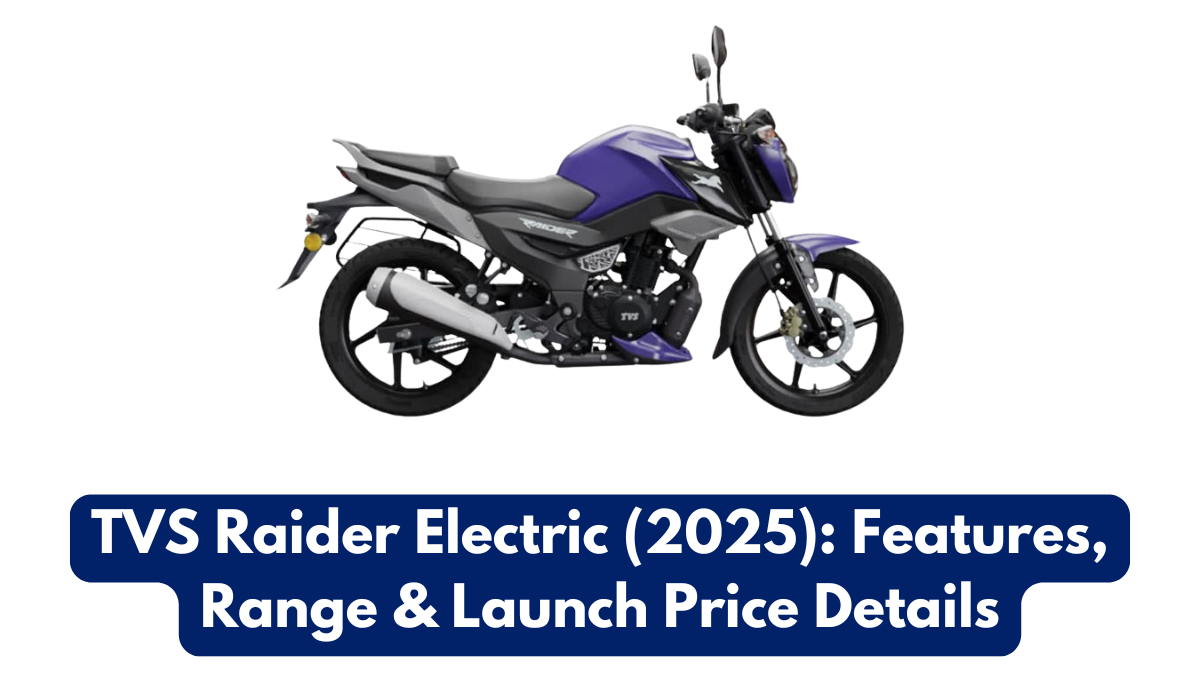The TVS Raider Electric 2025 is one of the most anticipated TVS EV launches in India, representing the brand’s commitment to sustainable mobility and high-performance urban commuting. This Raider 2025 model combines agility, smart technology, and efficiency in a sleek package, making it a standout in the rapidly growing electric two-wheeler segment. With its upcoming launch in major Indian cities, the TVS Raider Electric 2025 promises to offer an optimal mix of performance, safety, and affordability, catering to both daily commuters and environmentally conscious riders.

Design and Build
The TVS Raider Electric 2025 features a modern, aerodynamic design that enhances performance and stability while offering a sporty aesthetic. Its aggressive front fascia, sleek LED headlamps, and sculpted body panels give it a contemporary look suitable for urban commuting. The lightweight yet durable frame ensures improved handling and agility in city traffic.
Inside the rider’s cockpit, the TVS EV integrates a fully digital instrument cluster that provides essential information such as speed, battery status, ride mode, and connectivity features. Ergonomically designed seating ensures comfort for both the rider and pillion, while the footrest and handlebar layout provide stability during long rides.
Key Design Features:
- Aerodynamic body with sharp, modern lines
- LED headlamps, taillights, and DRLs
- Ergonomic rider and pillion seating
- Alloy wheels with disc brakes for better control
- Fully digital instrument cluster with connectivity options
Powertrain, Battery, and Performance
The TVS Raider Electric 2025 is powered by a high-efficiency hub motor coupled with a lithium-ion battery pack. The scooter delivers smooth acceleration, instant torque, and energy-efficient performance, making it suitable for both city and short highway rides. It also offers multiple riding modes to optimize performance and battery efficiency.
The following table provides detailed specifications of the TVS EV Raider 2025:
| Variant | Motor Type | Battery Capacity | Power (PS) | Torque (Nm) | Top Speed (km/h) | Range (km) | Charging Time |
|---|---|---|---|---|---|---|---|
| Base EV | Hub Motor | 3.3 kWh | 5.5 | 18 | 65 | 95 | 4 hrs (AC) |
| Mid EV | Hub Motor | 3.7 kWh | 6.5 | 20 | 70 | 115 | 4 hrs (AC) |
| Premium EV | Hub Motor | 4.2 kWh | 7.5 | 25 | 75 | 135 | 3.5 hrs (AC/Fast) |
This setup ensures that the TVS EV delivers an optimal combination of acceleration, top speed, and range, addressing the needs of urban commuters who require efficiency without compromising on performance.
Features and Technology
The TVS Raider Electric 2025 comes equipped with a wide range of smart features designed to enhance safety, convenience, and connectivity. Riders can monitor battery status, optimize riding modes, and navigate efficiently through the app-based system integrated with the scooter.
Key Features:
- Fully digital display with speed, battery, and connectivity metrics
- Multiple riding modes including Eco, Normal, and Sport
- Smart regenerative braking to extend battery life
- App connectivity for navigation, battery monitoring, and ride analytics
- LED lighting system for enhanced visibility
- Lightweight and durable frame for superior handling
These features make the Raider 2025 a versatile TVS EV, suitable for daily commuting while offering advanced technology for convenience and safety.
Range and Efficiency
The TVS Raider Electric 2025 offers an impressive range that caters to city commutes and occasional longer rides. Depending on the variant, riders can expect 95 km to 135 km on a single charge. Regenerative braking further improves efficiency by recapturing energy during braking and feeding it back into the battery.
Expected Range by Variant:
- Base EV: 95 km
- Mid EV: 115 km
- Premium EV: 135 km
This makes the TVS EV Raider 2025 a practical solution for urban commuters, providing confidence in range and convenience for everyday usage.
Expected Price and Launch
The price in India for the TVS Raider Electric 2025 is expected to range from ₹1.20 lakh for the base variant to ₹1.60 lakh for the premium variant with enhanced battery and features. The launch timeline is expected in early 2025, initially targeting metropolitan cities such as Bangalore, Delhi, and Mumbai, where adoption of electric two-wheelers is higher.
Expected Price Range (Approximate):
- Base EV Variant – ₹1.20 lakh
- Mid EV Variant – ₹1.40 lakh
- Premium EV Variant – ₹1.60 lakh
With competitive pricing, robust performance, and advanced features, the TVS EV Raider 2025 is expected to attract attention from both urban commuters and technology-savvy riders.
Conclusion
The TVS Raider Electric 2025 sets a new benchmark in India’s electric scooter segment by combining advanced technology, sleek design, and practical range. As a premium TVS EV, it offers multiple riding modes, smart connectivity, and regenerative braking, making it a reliable choice for daily commuting. Its competitive price in India, ergonomic design, and upcoming launch timeline ensure that the Raider 2025 will appeal to environmentally conscious riders seeking a high-performance and stylish electric scooter. This launch reinforces TVS’s commitment to sustainable mobility while providing riders with a futuristic, efficient, and enjoyable riding experience.
FAQs
When will the TVS Raider Electric 2025 launch in India?
The launch timeline is expected in early 2025, with initial availability in major metropolitan cities.
What is the expected price in India for the Raider Electric 2025?
The price in India is expected to range from ₹1.20 lakh to ₹1.60 lakh depending on the variant.
What is the top speed of the TVS Raider Electric 2025?
The TVS EV Raider 2025 offers a top speed ranging from 65 km/h to 75 km/h depending on the variant.
What is the range of the TVS Raider Electric 2025?
The Electric Scooter provides a range between 95 km and 135 km on a single charge depending on the variant.
Does the TVS Raider Electric 2025 come with smart connectivity features?
Yes, it includes app connectivity for navigation, battery monitoring, and ride analytics.
Click here to know more.